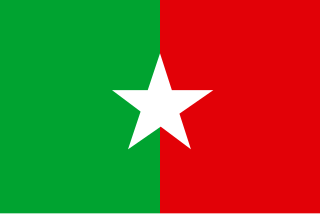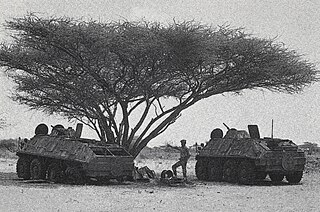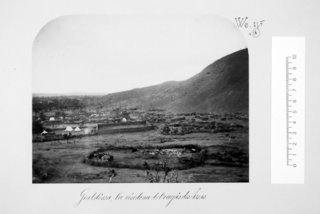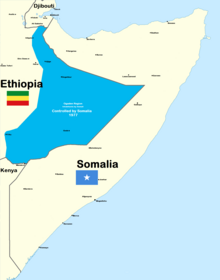
The Ethiopian National Defense Force (ENDF) is the military force of Ethiopia. Civilian control of the military is carried out through the Ministry of Defense, which oversees the Ground Forces, Air Force, Naval Force as well as the Defense Industry Sector.

The Somali Democratic Republic (Somali: Jamhuuriyadda Dimuqraadiya Soomaaliyeed; Arabic: الجمهورية الديمقراطية الصومالية, al-Jumhūrīyah ad-Dīmuqrāṭīyah aṣ-Ṣūmālīyah; Italian: Repubblica Democratica Somala; was the name of the socialist totalitarian military government given to Somalia under President Major General Mohamed Siad Barre, after seizing power in a coup d'état on 21 October 1969. The coup came a few days after a bodyguard assassinated Abdirashid Shermarke, the nation's second President. Barre's administration ruled Somalia for the next 21 years until Somalia collapsed into civil war in 1991.

Ogaden is one of the historical names used for the modern Somali Region which forms the eastern portion of Ethiopia and borders Somalia. It includes another region in the north known as the Haud.

The Western Somali Liberation Front was an Ogaden separatist group fighting in eastern Ethiopia to liberate the Ogaden region from Ethiopian control. It played a major role in the Ogaden War of 1977–78, assisting the invading Somali Army.

Dire Dawa is a city in eastern Ethiopia near the Somali Region and Oromo border and one of two chartered cities in Ethiopia. Dire Dawa alongside present-day Sitti Zone were a part of the Dire Dawa autonomous region of the Somali Region stipulated in the 1987 Ethiopian Constitution until 1993 when it was split by the federal government into a separately administered chartered city.

The Ogaden War, also known as the Ethio-Somali War, was a military conflict fought between Somalia and Ethiopia from July 1977 to March 1978 over the sovereignty of Ogaden. Somalia's invasion of the region, precursor to the wider war, met with the Soviet Union's disapproval, leading the superpower to end its support for Somalia to fully support Ethiopia instead.

The Ogaden National Liberation Front is a social and political movement, founded in 1984 to campaign for the right to self-determination for Somalis in the Ogaden or Somali Region of Ethiopia. Its armed wing, led by Ogaden national army waged an insurgency against the Ethiopian government from 1994 to 2018.

The Somali National Army is the ground forces component of the Somali Armed Forces, and is the largest out of the three service branches that make up the majority of the Armed Forces.
Gode is a city in the Somali Region of Ethiopia. Located in the Shabelle Zone, the city was the capital of the Somali Region until 1995 when Jijiga became the capital

The 1982 Ethiopian–Somali Border War occurred between June and August 1982 when Ethiopia, sending a 10,000 man invasion force backed by warplanes and armored units, supported by thousands of Somali Salvation Democratic Front (SSDF) rebels invaded central Somalia.
Chinaksen is a town located in Chinaksen woreda, East Hararghe Zone of the eastern Oromia Region, Ethiopia. This city has a latitude and longitude of 9°30′N42°42′E with an elevation of 1816 meters above sea level. Chinaksan is a historical settlement with stone walls built at the foot of an oval hill; on the hill are ruins of fortifications of Adalite origins during the Adal Sultanate period.

Jaldessa is a village in eastern Ethiopia. Located in the Shinile Zone of the Somali Region of Ethiopia.

The military history of Somalia encompasses the major conventional wars, conflicts and skirmishes involving the historic empires, kingdoms and sultanates in the territory of present-day Somalia, through to modern times. It also covers the martial traditions, military architecture and hardware employed by Somali armies and their opponents.

Abdullahi Ahmed Irro, also known as Abdullahi Ahmed Yusuf Irro, was a prominent Somali military professor and general. He helped establish the National Academy for Strategy.

The Battle of Jijiga was a series of battles that was part of the Ogaden War. The battles were fought in Jijiga, Ethiopia and was one the largest battles of the conflict.
The military history of Djibouti encompasses the major conflicts involving the historic empires and sultanates in the territory of present-day Djibouti, through to modern times. It also covers the martial traditions and hardware employed by Djiboutian armies and their opponents.
The Battle of Harar was a battle of the Ogaden War. The battle took place from October 1977 until January 1978, and was fought near Harar, Ethiopia. The Cuban soldiers took part supporting the Ethiopian army, during the battle they engaged the attackers in vicious fighting.

Cuban foreign policy during the Cold War emphasized providing direct military assistance to friendly governments and resistance movements worldwide. This policy was justified directly by the Marxist concept of proletarian internationalism and was first articulated by Cuban leader Fidel Castro at the Organization of Solidarity with the People of Asia, Africa and Latin America in 1966. However, as an informal policy it had been adopted as early as 1959, shortly after the Cuban Revolution. It formed the basis for a number of Cuban military initiatives in Africa and Latin America, often carried out in direct conjunction with the Soviet Union and Warsaw Pact member states which provided advisory or logistical support. These operations were often planned by the Cuban general staff through an overseas headquarters known as an internationalist mission.

The Battle of Dire Dawa were a series of battles that took place since 17 July to 17 August 1977 between Ethiopian Armed Forces and Somali Armed Forces near the town of Dire Dawa, Ethiopia and adjacent to the airfield of the same name during the Ogaden War.














